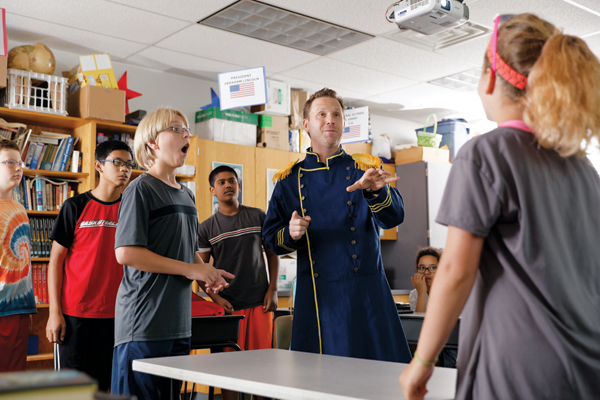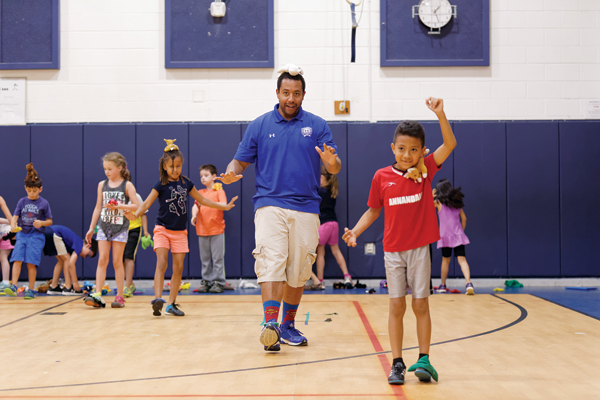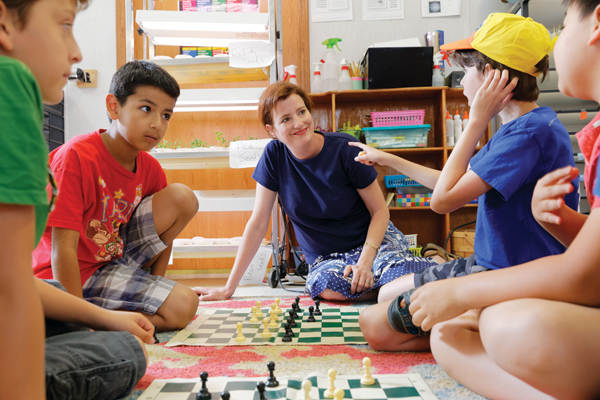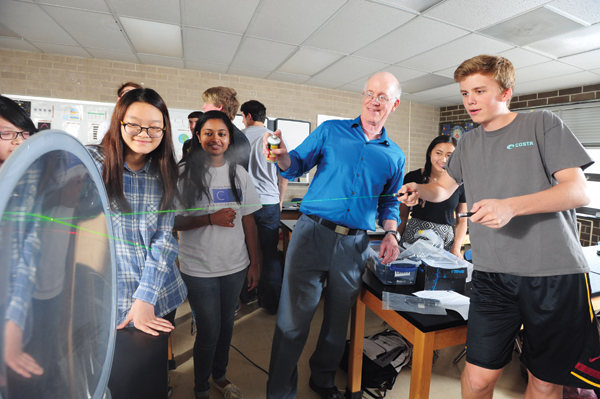Kristin Shymoniak
Lead Special Education and 4th-Grade Resource Teacher
Barcroft Elementary School, Arlington
Years teaching: 5
When I was in the second grade, I had to write a paper about what I wanted to be when I grew up. I said I wanted to help people with disabilities.
Most people underestimate children with autism or special needs. They’re so resilient—so strong and determined to prove the stigma wrong. And they’re very aware of the world around them. Just from a different perspective.
As a teacher, you have to be flexible yet consistent. When you work with the autism community, anything that deviates from the routine is mayhem. But sometimes you have to throw in a monkey wrench, just to help them learn to deal with that.
My first year teaching here we had an earthquake. That was the worst day ever. Preparing students for things like that is difficult.
Every child with autism is different. Things that calm them down are really individual: music, a swing, holding a preferred item, telling a “social story” and using them in it. I’m a swimmer and that calms me down. And music—especially on a record player. I think the white noise in the background calms me. Also, running. And prayer.
I try to engage students both in and out of the classroom as much as possible. I go to sporting events, recreation events, recitals. I’ve gone to church with them. Last year I had a student who had never been to a professional sports event, so on the last day of school I took him to the Nats game.
Barcroft is culturally diverse. I’ve learned to never turn down food when you’re offered food. We also have a lot of commonalities. Being a minority, there are struggles that I face and that [my students’] parents face.
Students with learning disabilities know each other’s strengths and weaknesses and they team up to tackle things. They empower each other.
The worst days are when their attention is below zero and I feel like I’ve hit a brick wall, like I’m not getting through. The best days are when a student makes a connection to something. And when they teach me something.
I use a lot of movement. Whip and Nae Nae [the song by Silentó]—I use that for my math instruction. For Nae Nae, you put your hand up. So when I teach fractions, I tell them Nae Nae is at the top; you Nae Nae for the numerator.
I believe in my kiddos. They all have their strengths. They all have the potential to do something world-changing.
—Madelyn Rosenberg
Tony Philippon
6th-Grade History, Civics & Economics Teacher
Swanson Middle School, Arlington
Years teaching: 16
Our nation’s history is messy. Students need to grapple with these topics to appreciate the progress we’ve made and how their lives have been affected by those who came before us.
Every child has different learning strengths. I teach to those strengths in a variety of ways. We’ll play “Civil War Capture the Flag” or I’ll dress up as George Washington and re-create the Constitutional Convention. We do a lot of simulations, role-playing, debating, questioning.
I didn’t choose middle school; middle school chose me.
I’ve learned not to take myself too seriously. I like to tell jokes and ham it up. Teaching is part entertainment. We’re onstage every day. If you can hook them on the first day of school, you have them for the whole year.
I’ve learned to tell kids that I don’t have all the answers. Asking and developing questions is more important than having answers. I want them to ask a million questions. There’s no question that’s too small or too big.
Misery is always optional. I choose to teach with laughter and enthusiasm.
Though I teach the same topic five times a day, every class is different with its own personality.
Kids deserve to feel safe, respected and validated. When this happens, their minds are free to learn anything we want them to.
Building positive and meaningful relationships is what matters most. In the end, it isn’t what we have taught or what their SOL scores are; it’s those relationships that last beyond the school year.
Before the year’s over, I try to learn at least two unique things about every single student.
I want my students to walk away from my class feeling inspired, confident and that they matter. I want them to learn how to question, how to see issues from multiple perspectives, to take risks and to be empathetic. I think history is a great means to that.
—Madelyn Rosenberg
Barbara Piscopo
Theatre Arts Teacher (recently retired)
Mary Ellen Henderson Middle School, Falls Church
Years teaching: 17
As a kid I would not dress up for anything. I thought Halloween was stupid. But now I am happy to look totally foolish. My students are the ones who taught me how to play. One day a student knocked on my door and said, “Ms. Piscopo, will you be the SOL Fairy?” So I found an old bridal gown and made some wings and got a wand. The kids made a video with me as the SOL Fairy, encouraging students to relax and just do their best on those tests.
By the time I retired this past spring I had produced 13 plays, including Fiddler on the Roof, Seussical and Alice in Wonderland. I would look at the kids each year and think about what shows were available and how the personalities of each group would fit a certain show. I have had up to 98 kids in a play, but the average is 80.
I have ADHD. I was diagnosed at 60. I had always wondered why my concentration was all over the place. Whenever I did a show, though, I could focus. I need that framework, that freedom of expression. To this day, if I have to give a speech, I will put it in a song. Theater and all the arts saved my life.
I have three [adult] children. My two daughters were both in plays in high school, not always willingly. I remember bribing my second daughter with Backstreet Boys tickets so she would try out for Annie. She ended up getting the lead role. My son is also a very talented performer.
It is amazing what comes out of the kids. Their creativity and imagination just blow me away. I am really going to miss them.
I remember my kids as the parts they played. I ran into the mother of one of my former students at Giant. I told her he was the best “Thing 1” I have ever seen. He’s at the U.S. Naval Academy now.
I always looked for the kids who had something in them that hadn’t blossomed yet. As a child, I had a teacher who recognized talent in me, and she gave me my first part. It gave me confidence, and I have been blessed with the ability to let my kids experience that confidence for themselves.
—Amy Rogers Nazarov
Stevie Gray
PE Teacher
Glebe Elementary School, Arlington
Years teaching: 8
When kids start kindergarten it’s a lot like herding cats. The first thing I have to show them is how to move and make them aware of their space.
If I come in and say, “This is Mr. Gray’s favorite game,” it’s going to be their favorite game. One of my favorites is Bean-Bag Shoe Tag.
Every morning I’m out front greeting kids and high-fiving and saying “Good morning.” There are always smiles. There’s always a bounce. They’re always ready to tell you something or have a story. It gives me life.
I call them all “boss.” Some of them probably think I just don’t know their names, but I do; I know all of their names. We’re close to 600 right now.
I believe physical education is the most important subject. Not to downplay math, but even if you’re not good at math you can move on in life. You only get one body forever. You have to know how to take care of it so you can keep going as long as possible.
Biceps bend. Triceps extend.
I’ve always liked Superman. The truth and justice thing hits home. I was diagnosed with lymphoma four years ago. Every time I went in for treatment, I wore a Superman shirt. The doctor said being young and healthy helped me deal with the treatments, which were pretty intense.
Sportsmanship doesn’t just mean you don’t boo the other person. It’s how do you treat your teammates if they make a mistake? How do you celebrate them if they do something awesome?
Family life is the nurse’s responsibility. But right around November or December, we tell the fifth-graders: You need to go ask your parents about deodorant.
If you’re watching TV and there’s a commercial, get up and move around. I alternate between pushups and curl-ups and jumping jacks.
The goal of any physical education program should be to create physically literate children. Students who make healthy decisions can participate in physical activity now and for the rest of their lives.
The best thing parents can do to help kids stay fit is to get them active. A lot of people think that means signing them up for a team, but not everybody likes a team. If they want to try baseball, get out with them and go to a park and throw a ball. Don’t make it competitive right away. That’s how people quit.
—Madelyn Rosenberg
Kathy Doane
4th-Grade Advanced Academic Programs (AAP) Teacher
Haycock Elementary School, Falls Church
Years teaching: 20
On the first day of school I’m super-nervous, just like the kids. I still get butterflies. Will they like me? Will I like them?
Ten is a great age. They are starting to become more curious and develop their own opinions. Adolescence has not yet begun. The hormones have not yet kicked in. They still have a sense of wonder about the world.
Children need to fail sometimes. We should not be swooping in to help before they have even asked for help. It undermines their confidence, their sense of self.
The “difficult” children are the ones I learn the most from. I recall one child who was challenging, always messing with the other children. He and I had a bunch of talks. Eventually I figured out that he had been bullied for years.
I was bullied in middle school. I remember adults telling me to ignore it. Now the issue gets a lot more attention. We talk about how bullies tend to have some kind of social power. Our guidance counselor helps our teachers and students understand what it is and how to fight it.
If a teacher tells you that your child has behaved badly, give the teacher the benefit of the doubt. The teacher is not lying to you. In fact, it was probably very difficult to tell you about your child’s bad decision. All kids make mistakes. We won’t hold it against them forever or peg them as a “bad kid.”
Children learn better when they can figure out on their own why certain things happen. For a unit on electricity, I give the kids a battery, a lightbulb and a wire and tell them to light the bulb with no additional instructions. Once they figure out how to do it, we talk about electrons and circuits. At that point they can anchor this new knowledge with their own discovery. That’s how learning sticks.
On the first day of summer vacation I like to sleep in and then take my daughters (now 13 and 15) out to lunch. And I usually start reading all the books I’ve been saving up. I don’t get to read as much as I would like during the school year.
—Amy Rogers Nazarov
Bob Foley
AP Physics Teacher
Langley High School, McLean
Years teaching: 6
I was an engineer for 30 years before I started teaching. I started as a nuclear engineer right around the time of Three Mile Island, the partial nuclear meltdown that occurred in 1979 in Pennsylvania. I was also a telecommunications engineer.
High school students are expected to maintain focus for many hours. The great thing about physics is that they (and I) get to walk around the lab and outside and do stuff.
Many students feel trepidation at the beginning of the school year. They have heard from their parents that “Physics is so hard!” But it’s taught differently now than it was when their parents were in school; it’s much more collaborative.
The less I talk during classroom time, the better. Kids learn when they are working together to solve a problem.
Each year we do a “zip line lab,” which is a study in acceleration—although somewhat to their chagrin, the students do not actually get to ride a zip line. I attach a 35-meter-long wire cable to the bleachers, then hang a little pulley hook with a weight on it. We attach an Albert Einstein bobble-head doll to the hook and let it fly. The students time it with their cellphone timers, establishing that he is going faster at the bottom than at the top.
In June I always give my end-of-the-year non-physics lecture. We talk about how rising seniors will be seduced all summer long by college admissions departments. To students who doubt themselves, I say to turn the equation around and say, “I know I am worth it to you; are you worth it to me?” I want to get them thinking about going to the college that is right for them. You can get great educations lots of places—and not necessarily come out $100,000 in debt.
—Amy Rogers Nazarov






